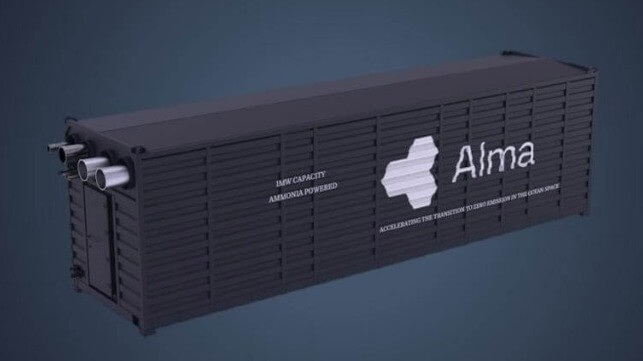Highest Power Output Demonstrated from Direct Ammonia Fuel Cell

Norway’s Alama Clean Power, a company focusing on the development of applications of Solid Oxide Fuel Cells for the maritime sector, reports it has achieved a key milestone in the efforts to develop commercial-scale systems. The company tested the largest direct ammonia fuel cell, a key building block for future systems.
Alma, which was the first venture to be launched out of Clara Venture Labs, a venture platform backed by Aker, is developing a technology that enables the direct feeding of ammonia into the fuel cell system. The concept bypasses the need for any energy-intensive pre-treatment that converts the fuel into hydrogen before electricity production. According to the company’s research, it will produce significantly higher efficiency levels compared to traditional combustion engines, having the potential to make ammonia-operated maritime energy systems economically viable for ship owners.
CEO Bernt Skeie notes that Alama has been working on the development of the system for just over a year as part of its effort to develop modularized Solid Oxide Fuel Cell systems. The unit that successfully tested produced 6kW from the direct ammonia fuel cell.
“To our knowledge, this is the highest power output ever demonstrated with direct ammonia solid oxide fuel cells,” said Skeie.
Alma’s design for the SOFC modules is combustion-free with no rotating parts. They are designed to operate autonomously without any maintenance need for long intervals. Green ammonia, produced by electrolysis powered by renewables, is a carbon-free fuel that the company believes has great potential to decarbonize the maritime industries.
“It’s rewarding to see the system operate with stable operation and consistent electricity generation,” said Rune Tveit, Project Manager. “To gain knowledge and fine-tune the setup, testing will continue throughout the summer. After that, we will proceed with the assembly and testing of a complete 100-kW module which will serve as the foundation for larger ship installations.”
At the beginning of 2023, the company reported that its design of a 1 MW ammonia-fueled SOFC system received Approval in Principle (AiP) from DNV. The SOFC system design has been evaluated for compliance with DNV class rules and IMO guidelines for fuel cell installations. The AiP was granted for a containerized module that includes safety systems to handle ammonia as fuel.
The company is working on a range of prototype demonstration projects from some of the leading companies in different parts of the maritime industry. With MSC Cruises they worked on a fuel cell for the cruise ship MSC World Europa, while with Odfjell, Wärtsilä Norway, and AkerBP, they are working on an LNG-fueled solid oxide fuel cells featuring integrated carbon capture to be demonstrated on an Odfjell chemical tanker.
The EU is funding two pivotal projects, including a 2 MW ammonia-operated solid oxide fuel cell module that will be retrofitted onboard the offshore vessel Viking Energy owned by Eidesvik and on contract with Equinor. The second project calls for demonstrating a 100-kilowatt LOHC (Liquid Organic Hydrogen Carrier) based power train on board the offshore supply vessel Edda Ferd, which is operated by Østensjø Rederi.
